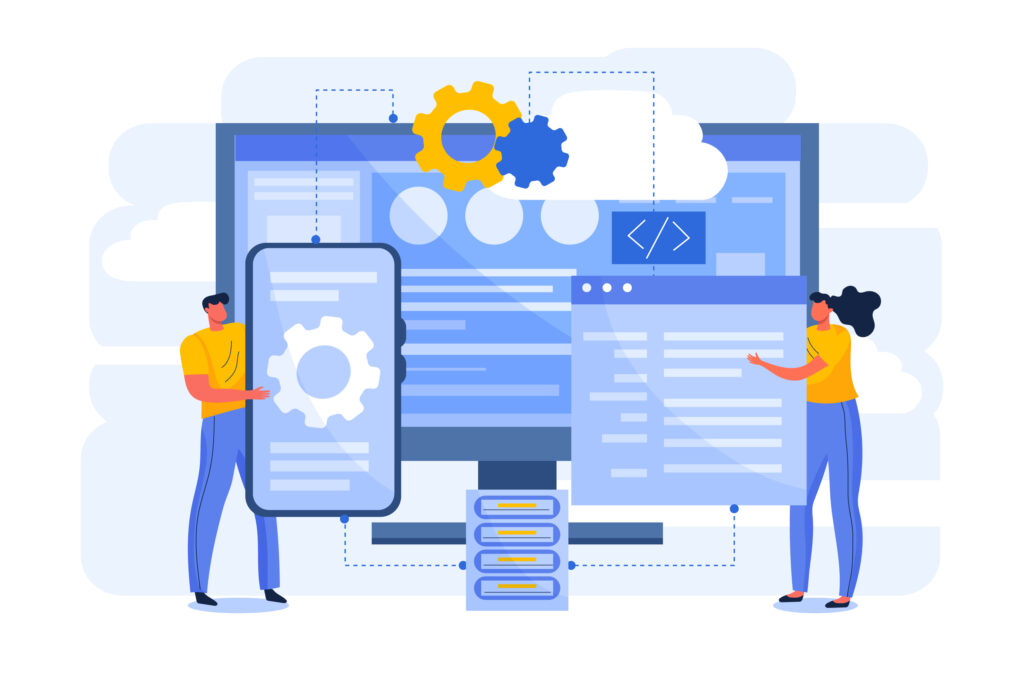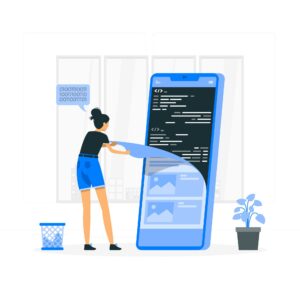Understanding the Difference Between Native Apps and Hybrid Apps
Difference Between Native Apps and Hybrid Apps is a crucial consideration for businesses aiming to develop effective mobile applications. Native apps are specifically designed for a particular operating system, offering superior performance and user experience by leveraging device capabilities.

In contrast, hybrid apps combine elements of both native and web applications, allowing for a single codebase that runs on multiple platforms, which can lead to cost savings and faster deployment. This article will explore the key distinctions between these two approaches, highlighting their advantages, disadvantages, and ideal use cases to help guide your app development decisions.
Native Apps
Native apps are specifically designed for a particular operating system (OS), such as iOS or Android. They are created using programming languages and tools that are unique to each platform, enabling them to fully utilize the capabilities of the devices they operate on.
Key Characteristics of Native Apps:

- Programming Languages: Native apps for iOS are usually developed in Swift or Objective-C, whereas Android applications are built using Java or Kotlin.
- Performance: These apps deliver exceptional performance and responsiveness by interacting directly with the device’s hardware and software. This leads to a seamless user experience, particularly for applications that require high graphics performance, such as games.
- User Experience (UX): Native apps offer a rich user experience that closely follows the design standards of their respective platforms, making them intuitive for users. This customized design approach significantly improves usability and user satisfaction.
- Access to Device Features: They have complete access to device functionalities like GPS, camera, and notifications, enabling the development of more sophisticated features.
- Development Time and Cost: Creating native apps can be both time-intensive and costly since developers need to maintain separate codebases for each platform. This process demands specialized expertise in various programming languages and tools.
Examples of Native Apps
- Instagram (iOS version)
- Google Maps (Android version)
- Spotify (available on both iOS and Android)
- Apple Music (iOS version)
- Uber (available on both iOS and Android)
Hybrid Apps

Hybrid apps merge features of both native and web applications. They are essentially web applications encapsulated in a native shell, enabling them to operate across multiple platforms using a single codebase.
Key Characteristics of Hybrid Apps:
- Programming Languages: Hybrid apps are developed using web technologies like HTML, CSS, and JavaScript. Common frameworks include React Native, Ionic, and Apache Cordova.
- Cross-Platform Compatibility: One of the main benefits is their ability to function on various platforms (iOS, Android) with a single codebase, significantly reducing development time and costs.
- Performance: Although hybrid apps can perform adequately for simpler tasks, they typically do not achieve the same performance as native apps due to their dependence on web technologies. Performance can also be influenced by network conditions since many hybrid apps retrieve data from servers.
- User Experience: Hybrid apps strive to replicate the appearance and feel of native applications but may not completely match platform-specific UI elements, which can lead to a less intuitive user experience compared to native apps.
- Development Time and Cost: They generally have shorter development cycles and lower costs since developers can write code once for multiple platforms.
Examples of Hybrid Apps
- Uber
- Gmail
- Tinder
Comparison Table Between Native and Hybrid Apps
The following table outlines the key differences between native and hybrid app development, focusing on several critical features. Each feature is explained in detail, highlighting its implications for developers and businesses.
| Feature | Native Apps | Hybrid Apps |
| Programming Languages | Swift/Objective-C (iOS), Java/Kotlin (Android) | HTML, CSS, JavaScript |
| Performance | High (optimized for specific OS) | Moderate (depends on web view) |
| User Experience | Superior (platform-specific) | Good but less tailored |
| Development Cost | Higher (separate codebases needed) | Lower (single codebase) |
| Time to Market | Longer (more complex development) | Shorter (faster deployment) |
| Access to Device Features | Full access | Limited access |
| Maintenance Complexity | Higher (multiple codebases) | Lower (single codebase) |
This comparison illustrates that while native apps provide superior performance and a more tailored user experience due to their platform-specific design, hybrid apps offer cost-effective solutions and quicker development times by utilizing a single codebase across multiple platforms.
Programming Languages
Native Apps:
These applications are created using platform-specific languages, such as Swift or Objective-C for iOS, and Java or Kotlin for Android. This specialization allows developers to fully exploit the capabilities of the respective operating systems, resulting in enhanced performance and improved user experiences.
Hybrid Apps:
In contrast, hybrid apps are developed using standard web technologies like HTML, CSS, and JavaScript. This approach enables a single codebase to be deployed across multiple platforms, simplifying the development process but potentially limiting performance and access to device features.
Performance
Native Apps:
They typically deliver high performance because they are specifically optimized for the operating system on which they run. By directly leveraging device hardware, native apps achieve faster load times and smoother interactions.
Hybrid Apps:
The performance of hybrid apps can be moderate since they rely on a web view to display content. This reliance often results in slower performance compared to native apps, particularly in applications that require intensive graphics processing.
User Experience
Native Apps:
These applications deliver an exceptional user experience that is specifically designed to align with the guidelines of the platform they operate on. This results in intuitive navigation and interaction patterns that users expect from their devices.
Hybrid Apps:
Although hybrid apps strive to replicate the native look and feel, they may not completely reproduce platform-specific UI elements. This can lead to a less cohesive user experience compared to native applications.
Development Cost
Native Apps:
The development of native apps usually involves higher costs because separate codebases are required for each platform. This necessitates more resources in terms of both development time and specialized expertise.
Hybrid Apps:
In contrast, hybrid apps are generally more cost-effective as they enable developers to create one codebase that functions across multiple platforms. This approach significantly reduces both development and maintenance costs.
applications.
Time to Market
Native Apps:
The time to market for native apps is often longer due to the complexity involved in developing distinct applications for each platform. This process requires substantial time investment in coding, testing, and debugging.
Hybrid Apps:
Hybrid apps can be developed more rapidly thanks to the single codebase strategy. This allows for quicker deployment across various platforms, making them particularly suitable for projects with tight deadlines.
Access to Device Features
Native Apps:
These applications have complete access to all device features, including GPS, camera, and push notifications. This capability enables developers to create rich functionalities that fully utilize the hardware capabilities of the device.
Hybrid Apps:
In comparison, hybrid apps have limited access to device features. While many hybrid frameworks offer plugins to access native functionalities, this can introduce performance overhead and may restrict certain functionalities.
Maintenance Complexity
Native Apps:
Maintaining native apps involves higher complexity since updates must be implemented separately for each platform. This can lead to increased costs and resource allocation for ongoing support.
Hybrid Apps:
On the other hand, hybrid apps benefit from lower maintenance complexity due to their single codebase. Updates can be deployed simultaneously across all platforms, simplifying the maintenance process.
Advantages and Disadvantages of Native and Hybrid Apps

Advantages of Native Apps
- Performance: Native apps are celebrated for their exceptional speed and responsiveness. Built using the specific programming languages of their respective platforms (e.g., Swift for iOS, Kotlin for Android), they interact directly with device hardware and APIs, eliminating additional layers that could slow down performance. This results in faster load times and smoother operation, particularly beneficial for resource-intensive applications like games or video editing tools.
- User Experience: These apps provide a superior user experience by closely following the design guidelines of the operating systems they operate on. This adherence ensures that users encounter familiar interfaces and interactions, enhancing satisfaction and usability. The intuitive design facilitates easier navigation, positively impacting user retention and app ratings.
- Offline Functionality: A notable advantage of native apps is their ability to operate offline. By storing data locally on the device, users can access essential features without an internet connection, which is especially useful for applications like games or navigation tools that rely on pre-loaded content.
- Security: Native apps typically offer higher security compared to hybrid apps. They utilize the security features of the operating system, such as file encryption and secure storage for sensitive data. Additionally, native apps are less vulnerable to the risks associated with web technologies, making them a safer option for applications that handle confidential information.
Disadvantages of Native Apps
- Development Cost: Native apps often incur higher development costs due to the necessity of maintaining separate codebases for each platform. This requirement demands more resources in terms of development time and expertise.
- Time to Market: The time to market for native apps is generally longer because creating distinct applications for each platform involves significant investment in coding, testing, and debugging.
Advantages of Hybrid Apps
- Cost-Effectiveness: Hybrid apps are generally more economical since they allow developers to write one codebase that works across multiple platforms. This approach reduces both development and maintenance costs.
- Faster Development: The single codebase strategy enables quicker development cycles, allowing hybrid apps to be deployed more rapidly across various platforms. This makes them ideal for projects with tight deadlines.
Disadvantages of Hybrid Apps
- Performance Limitations: While hybrid apps can perform adequately for simpler applications, they generally do not match the performance levels of native apps due to their reliance on web technologies. Performance can be impacted by factors such as network speed since many hybrid apps fetch data from servers.
- User Experience Challenges: Hybrid apps aim to mimic the native look and feel but may not fully replicate platform-specific UI elements, potentially leading to a less cohesive user experience compared to native applications.
- Limited Access to Device Features: Access to device features in hybrid apps is more restricted compared to native apps. Although many hybrid frameworks provide plugins for accessing native functionalities, this can introduce performance overhead or limitations in functionality.
Use Cases
Native Apps are Best Suited For:
- High-Performance Applications: Native apps excel in scenarios where high performance and complex functionalities are essential, such as gaming applications that require advanced graphics capabilities or apps that heavily utilize device features like cameras.
Hybrid Apps are Ideal For:
- Quick Deployment Across Multiple Platforms: Hybrid apps are well-suited for applications that need to be launched rapidly on various platforms with basic functionalities, such as content-driven apps. They are also a great choice for projects with budget constraints, allowing for broader market reach without significant investment.
[Want to learn more about the difference between native app and hybrid app? Click here to reach us.]
Conclusion
Understanding the distinctions between native and hybrid apps is essential for businesses and developers. Native apps are known for their superior performance, enhanced user experience, and full access to device features, making them ideal for applications that require high functionality and responsiveness. However, this comes with higher development costs and longer timeframes.
Conversely, hybrid apps provide a cost-effective solution with quicker deployment across multiple platforms, making them suitable for projects with budget constraints or those aiming to reach a broader audience without significant investment. While hybrid apps may not fully match the performance or user experience of native apps, they offer flexibility and efficiency in many scenarios.
For businesses looking to leverage the benefits of either approach, Bobcares offers comprehensive application development services tailored to meet specific needs. With over 20 years of experience, Bobcares specializes in custom mobile and web application development, ensuring high-quality solutions that enhance user engagement and drive business growth.
Their team provides ongoing support throughout the development lifecycle, from initial planning to deployment and maintenance. By partnering with Bobcares, businesses can confidently navigate the complexities of app development, ensuring they choose the right path—whether native or hybrid—to achieve their goals.







0 Comments